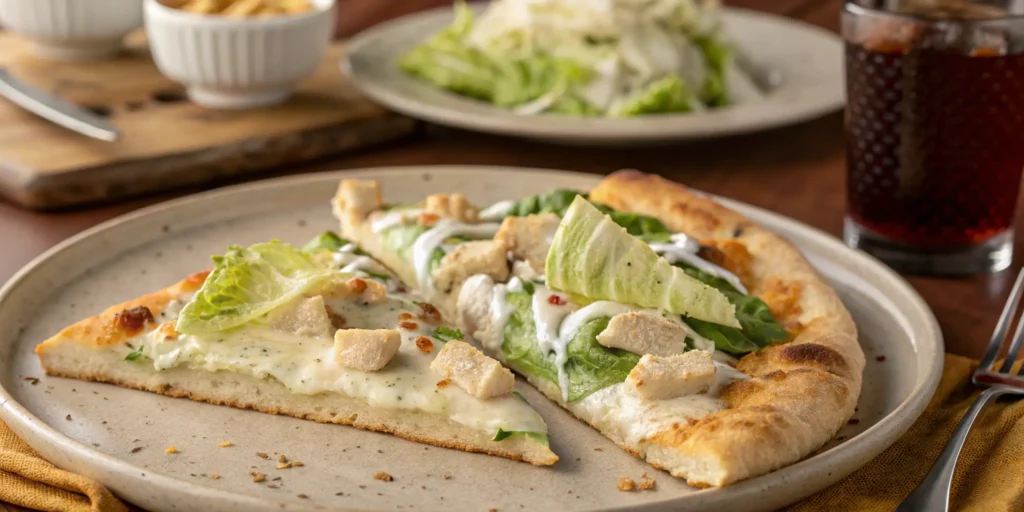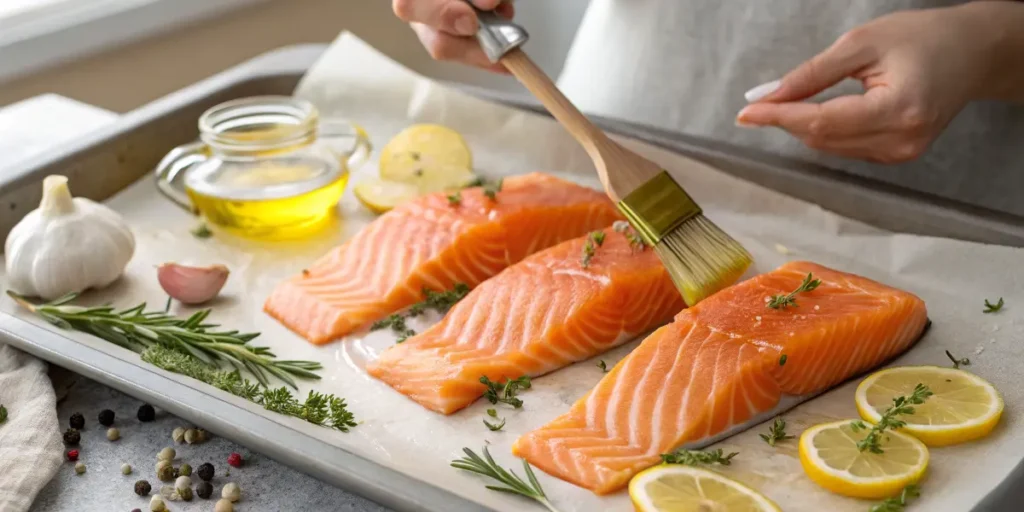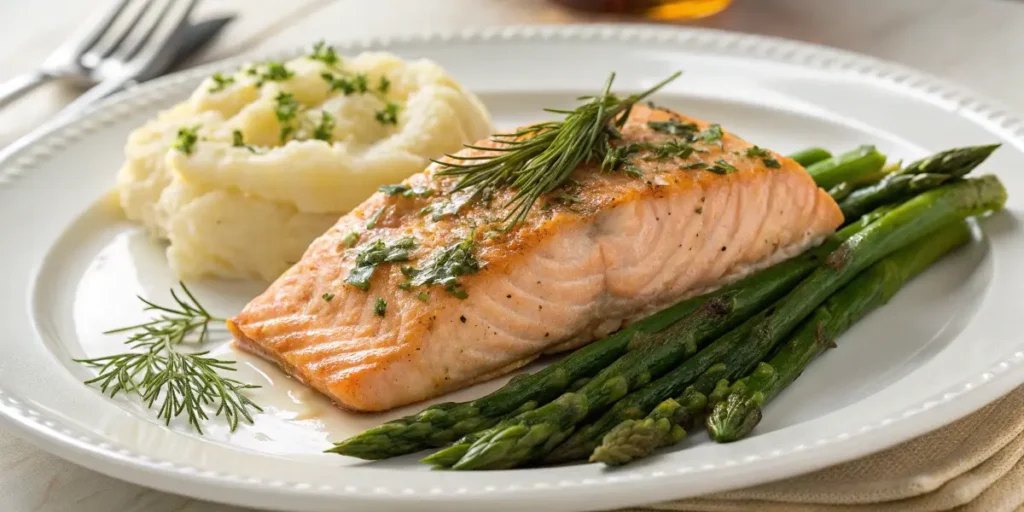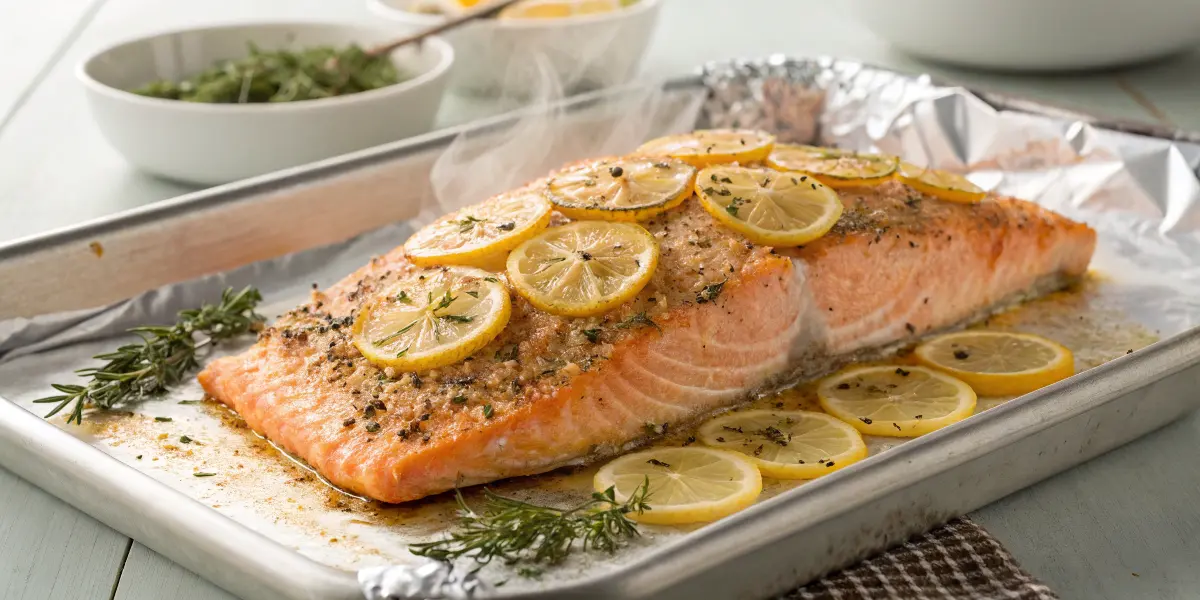How to Bake Salmon: 7 Easy Steps for Perfect Results Every Time
Table of Contents
Introduction: Why Baked Salmon Is the Ultimate Comfort Food
Imagine the warm aroma of lemon, garlic, and fresh herbs wafting through your kitchen as tender salmon bakes in the oven. It’s more than just a meal; it’s a moment of peace, a sense of accomplishment, and a nourishing way to treat yourself and your loved ones. Baking salmon is one of those cooking techniques that seems intimidating until you try it—and then you wonder why you didn’t start sooner. Whether you’re new to cooking or just looking to refine your skills, this guide will walk you through every step so you can achieve perfect results every time.
Why Baked Salmon Deserves a Spot in Your Weekly Meal Plan
Baking salmon at home is a game-changer. Not only is it quick and easy, but it also delivers restaurant-quality results without much effort. Here’s why it should be in your regular rotation:
- Rich in Nutrients: Salmon is packed with omega-3 fatty acids, high-quality protein, and essential vitamins like B12 and D.
- Low Effort, Big Flavor: Minimal prep and cook time make it ideal for busy weeknights.
- Versatile and Customizable: From bold spices to light, citrusy marinades, you can tailor it to your taste.
- Healthier Cooking Method: Baking retains nutrients and moisture better than frying or grilling.
Backed by science: According to the Harvard School of Public Health, omega-3s from fatty fish like salmon support heart health and brain function.
Choosing the Best Salmon for Baking
Fresh vs. Frozen Salmon
Both fresh and frozen salmon can work beautifully—what matters is quality.
- Fresh: Often more flavorful and tender, especially if you live near the coast.
- Frozen: Flash-frozen at sea to preserve freshness; convenient and budget-friendly.
Pro tip: Always thaw frozen salmon in the refrigerator overnight. Avoid thawing on the counter to prevent bacterial growth.
Wild-Caught vs. Farm-Raised
- Wild-Caught: Generally has a firmer texture and more complex flavor profile. Higher in omega-3s.
- Farm-Raised: More consistent in size and often milder in flavor. Look for responsibly farmed options.
Understanding Salmon Cuts
- Filets: Boneless, skin-on or skinless, best for baking.
- Steaks: Cross-section cuts with bone; richer flavor but require more handling.
- Whole: Ideal for large gatherings; more prep but visually impressive.
Ingredients You’ll Need to Bake Salmon Perfectly
Simple Salmon Bake Recipe Ingredients Table
| Ingredient | Quantity | Notes |
|---|---|---|
| Salmon fillets | 4 (6 oz each) | Skin-on preferred |
| Olive oil | 2 tbsp | Adds moisture and crisp edges |
| Lemon slices | 1 lemon | For flavor and garnish |
| Garlic (minced) | 2 cloves | Adds depth |
| Fresh herbs | To taste | Dill, parsley, or thyme recommended |
| Salt and black pepper | To taste | Essential seasoning |
Optional add-ins: paprika, Dijon mustard, honey, soy sauce, butter, chili flakes.

How to Bake Salmon – A Step-by-Step Guide
Step 1: Preheat and Prepare
Set your oven to 400°F (200°C). Line a baking sheet with foil or parchment paper for easy cleanup.
Step 2: Season the Salmon
- Pat salmon fillets dry with paper towels.
- Rub each filet with olive oil.
- Sprinkle with salt, pepper, and garlic.
- Lay lemon slices and herbs on top.
Step 3: Bake to Perfection
- Place fillets skin-side down on the baking sheet.
- Bake for 12–15 minutes, depending on thickness.
- Use a meat thermometer to check for doneness: internal temp should be 125°F–130°F.
Step 4: Let It Rest
Allow salmon to rest for 5 minutes before serving. This keeps it juicy and lets flavors settle.

Tips for Baking Salmon Like a Pro
- Avoid Overcooking: Salmon cooks fast. Always set a timer.
- Use Foil or Parchment: Helps retain moisture and makes cleanup easier.
- Experiment with Marinades: Try honey garlic, soy-ginger, or lemon-dill blends.
- One-Pan Meal Hack: Add asparagus, zucchini, or cherry tomatoes to the baking sheet.
Baked Salmon Variations and Flavor Ideas
Popular Marinades and Seasonings
- Honey Garlic Glaze: Mix honey, soy sauce, minced garlic, and a splash of lime juice.
- Lemon Dill Butter: Melted butter, lemon zest, and chopped fresh dill.
- Soy-Ginger Glaze: Soy sauce, grated ginger, sesame oil, and brown sugar.
- Spicy Cajun Rub: Paprika, cayenne, garlic powder, and a hint of brown sugar.
Side Dish Pairings
- Garlic mashed potatoes
- Roasted asparagus
- Lemon couscous
- Steamed broccoli with olive oil and sea salt
Storage and Reheating Tips
Storing Leftovers
- Refrigerate in airtight containers for up to 3 days.
- Freeze for up to 2 months; wrap tightly in foil or freezer bags.
Reheating Without Drying Out
- Use a skillet with a lid over low heat for moist results.
- Reheat in a preheated oven at 275°F until warm.
- Avoid microwaving unless necessary; if used, cover with a damp paper towel.
Common Mistakes to Avoid When Baking Salmon
- Skipping the Thermometer: Visual cues can be misleading.
- Baking Too Long: Salmon goes from moist to dry quickly.
- Not Resting After Baking: Essential for juicy texture.
- Cooking on a Dry Pan: Always use a lined tray.

FAQ – How to Bake Salmon: Common Questions Answered
How long does it take to bake salmon at 400°F?
It usually takes 12–15 minutes for a standard 6 oz filet. Thicker cuts may need a few extra minutes.
Should I cover salmon when baking it?
You can, especially if you want a very moist result. Foil helps trap steam.
Can I bake frozen salmon directly?
Yes, but it’ll take about 20–25 minutes at 425°F. Add extra seasoning to compensate.
What is the best internal temperature for baked salmon?
Aim for 125°F to 130°F. The salmon will continue to cook slightly as it rests.
How do I know salmon is done without a thermometer?
The flesh should flake easily with a fork and be opaque in the center.
Conclusion: Master the Art of Baking Salmon at Home
Now that you know exactly how to bake salmon to perfection, you’ve got a healthy, delicious dish you can rely on any night of the week. From choosing the right cut to flavoring it with your favorite herbs and sauces, you’re in full control of a meal that’s satisfying, nutritious, and surprisingly easy.
Don’t be afraid to experiment with seasonings and sides to make it your own. Remember, mastering a simple skill like baking salmon opens up a world of culinary possibilities.
Ready to Cook?
Try it out tonight and share your version with friends or family. Let them be the judge of your new go-to dish. And if you found this guide helpful, bookmark it or share it—because good food is meant to be shared.

